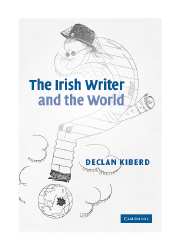Book contents
- Frontmatter
- Contents
- Acknowledgements
- A note on the text
- 1 Introduction
- 2 The fall of the Stage Irishman (1979)
- 3 Storytelling: the Gaelic tradition (1978)
- 4 Writers in quarantine? The case for Irish Studies (1979)
- 5 Synge, Yeats and bardic poetry (2002)
- 6 George Moore's Gaelic lawn party (1979)
- 7 The flowering tree: modern poetry in Irish (1989)
- 8 On national culture (2001)
- 9 White skins, black masks: Celticism and Négritude (1996)
- 10 From nationalism to liberation (1997)
- 11 The war against the past (1988)
- 12 The Elephant of Revolutionary Forgetfulness (1991)
- 13 Reinventing England (1999)
- 14 Museums and learning (2003)
- 15 Joyce's Ellmann, Ellmann's Joyce (1999)
- 16 Multiculturalism and artistic freedom: the strange death of Liberal Europe (1993)
- 17 The Celtic Tiger: a cultural history (2003)
- 18 The city in Irish culture (2002)
- 19 Strangers in their own country: multiculturalism in Ireland (2001)
- Index
6 - George Moore's Gaelic lawn party (1979)
Published online by Cambridge University Press: 22 September 2009
- Frontmatter
- Contents
- Acknowledgements
- A note on the text
- 1 Introduction
- 2 The fall of the Stage Irishman (1979)
- 3 Storytelling: the Gaelic tradition (1978)
- 4 Writers in quarantine? The case for Irish Studies (1979)
- 5 Synge, Yeats and bardic poetry (2002)
- 6 George Moore's Gaelic lawn party (1979)
- 7 The flowering tree: modern poetry in Irish (1989)
- 8 On national culture (2001)
- 9 White skins, black masks: Celticism and Négritude (1996)
- 10 From nationalism to liberation (1997)
- 11 The war against the past (1988)
- 12 The Elephant of Revolutionary Forgetfulness (1991)
- 13 Reinventing England (1999)
- 14 Museums and learning (2003)
- 15 Joyce's Ellmann, Ellmann's Joyce (1999)
- 16 Multiculturalism and artistic freedom: the strange death of Liberal Europe (1993)
- 17 The Celtic Tiger: a cultural history (2003)
- 18 The city in Irish culture (2002)
- 19 Strangers in their own country: multiculturalism in Ireland (2001)
- Index
Summary
‘Strike a blow for Irish by speaking it’, urged Eoin Mac Néill in an address to the first recruits of the Gaelic League, adding the afterthought that ‘if we cannot learn Irish we can at least stand up for it’. The history of Ireland in the decades after the foundation of the League in 1893 was to prove how much easier Mac Néill's second option was than his first. The brief career of George Moore as a leader of the Gaelic revival provides an apt and amusing illustration of that point.
It was a campaign which began, as all campaigns should, in a garret in London just one year after Mac Néill's rallying cry. One evening Moore's friend Edward Martyn expressed regret that he did not know enough Irish to write his plays in the language. Moore was astounded and remarked derisively to his friend: ‘I thought nobody did anything in Irish except bring turf from the bog and say prayers.’ Martyn was the first Anglo-Irish writer to give serious consideration to the possibility of employing Irish as a literary medium, but the nearest he ever came to his ideal was in his drama The Enchanted Sea, whose hero speaks fluent Irish, but only off stage. Despite his initial misgivings, Moore was soon excited by the possibility of Ireland ‘awakening at last out of the great sleep of Catholicism’.
- Type
- Chapter
- Information
- The Irish Writer and the World , pp. 91 - 104Publisher: Cambridge University PressPrint publication year: 2005
- 1
- Cited by

